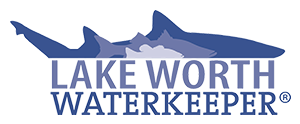A year-long study on the ability of a muck-collecting pit to keep sediment from choking the Lake Worth Lagoon found mixed results, leaving the embattled Palm Beach County estuary in a state of status quo.
It was the first assessment of a unique experiment that began in 2007 to divert harmful sediments flowing from Lake Okeechobee and the watershed into an up to 18-foot deep gash at the bottom of the C-51 Canal – a firehose that when discharged can cover lagoon oysters and paddle grass in dark goo.
The $77,000 study, contracted by the South Florida Water Management District with South Florida Engineering and Consulting, said in two out of six situations reviewed, the trap worked to minimally reduce the amount of so-called “suspended solids” flushed into the Lake Worth Lagoon.
In four of the tests, when there were higher flows of water through the canal, the trap had the negative effect of releasing sediment to the lagoon.
“We were all kind of hoping the report was just going to say we need to maintain it,” said Reinaldo Diaz, founder of Lake Worth Waterkeeper, an advocacy group for the lagoon. “It doesn’t seem like it’s a silver bullet, but it’s also not a complete failure. There is room for improvement.”
An agreement between the South Florida Water Management District, city of West Palm Beach and Palm Beach County called for regular maintenance of the trap, but it was unclear what that meant, water management district officials said.
While periodic measurements of muck depth have been made in the trap, last year’s study was the first comprehensive review of its effectiveness, even as 18 trillion gallons of Lake Okeechobee water flowed to the lagoon in 2016.
At about 40% full, it would cost an estimated $2 million to re-dredge the trap to its original 2007 capacity.
Jose Otero, a section administrator for the water management district who oversaw the sediment study, answered questions about the review at a Lake Worth Lagoon Initiative meeting Tuesday.
He said the study is not “definitive or conclusive.” It had few results that took a long time to get, he said.
“I think the district is trying to consider whether the information in this study is sufficient in making a recommendation on what is the next step, how urgent it is, and do we have some time to get a better handle on efficiency before we make a decision,” Otero said. “I don’t think the performance will be increased only by more frequent dredging.”
Dredging the muck also means finding a place to dry, clean and process it because it can contain high levels of arsenic.
Jeremy McBryan, Palm Beach County’s water resources manager, said the county is also still trying to digest the report to decide on the appropriate next steps. McBryan did note in Tuesday’s meeting that a handful of plans being considered as part of the Lake Okeechobee System Operating Manual would increase lake water going to the lagoon.
“The Army Corps is looking for places to put water that is going to the northern estuaries and there are many options on the table,” he said. “If you have an interest in the Lake Worth Lagoon, please get engaged and make sure the Corps understands the interest.”
Tens of millions of dollars have flowed to lagoon restoration efforts in the past two decades with more than 42 acres of new and improved habitat just since 2014. That includes building the Snook and Tarpon Cove islands, restoring of oyster beds, sea grasses and mangroves, and the construction of artificial reefs.
“Yes, we probably do need more study, and that’s kind of frustrating to hear,” Diaz said about the sediment trap.
He is concerned the lagoon’s troubles don’t get the same attention as the St. Lucie and Caloosahatchee estuaries.
The St. Lucie and Caloosahatchee estuaries bear the brunt of damage when a swollen Lake Okeechobee needs to release water, but stormwater from 30 municipalities and a 300,000-acre watershed also drain into the Lake Worth Lagoon.
“Everyone knows what is going on now isn’t working,” said Karen Marcus, president of Sustainable Palm Beach County, about the sediment trap. “It has never been maintained. It needs to be maintained, you have to get that stuff out of there.”
She said there is discussion about amending part of a proposed $150 million bond for environmental projects to earmark money to redesign the trap. That bond was supposed to go to Palm Beach County voters last year but was delayed because of the coronavirus. Marcus is hoping to get it back in front of voters in 2022.
Diaz said the Lake Worth Lagoon is not legally defined as a northern estuary of the greater Everglades – an exclusion that hurts it when water managers are looking for places to send Lake O overflow.
Until the mid-1800s, the Lake Worth Lagoon was a contained freshwater body, supplied primarily with water through ground seepage.
The Lake Worth Inlet, also called the Palm Beach Inlet, was first cut in the mid-19th century to open the lagoon to the Atlantic Ocean. In 1918, the inlet was stabilized and the channel widened and deepened to benefit the Port of Palm Beach.
In 1925-27 the Boynton Inlet, or South Lake Worth Inlet, was created.
“While it may not legally be defined as an estuary, scientifically, it clearly is,” Diaz said about the Lake Worth Lagoon.
Still, he’s optimistic that after 13 years, the water management district is reviewing the sediment trap’s effectiveness.
“It’s the first hard look at what we can do to make this better, which is very welcome,” he said.
Kmiller@pbpost.com
@Kmillerweather
